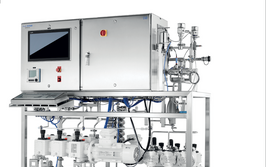Moving from Batch to Continuous
The first switch from batch to continuous manufacturing has been made – and approved by the FDA. Will pharma’s future be continuous?

There has been encouragement from many industry stakeholders, including the FDA, to switch from batch to continuous manufacturing. Implementing this change for already approved products is considered to be easier said than done, but it’s not impossible; in mid-April, the FDA for the first time approved a pharma manufacturer (Janssen) to switch from batch to continuous – and the agency hopes that more will follow suit. Janssen pursued the change for the production of Prezista (darunavir) via the FDA’s recently-released draft guidance to industry, Advancement of Emerging Technology Applications to Modernize the Pharmaceutical Manufacturing Base, which was introduced in 2015 with the specific aim of helping pharma manufacturers to implement new technology.
The reason for the FDA’s focus on new technologies is a desire to update the industry and its processes. In a recent blog post (1), Lawrence Yu, Deputy Director at the FDA Office of Pharmaceutical Quality, Center for Drug Evaluation, suggested that a time-traveling pharmaceutical scientist from the 1960s would be very much home in today’s industry. “They would already be very familiar with most of the processes and production techniques being used. That’s because not much has changed in pharmaceutical production over the last 50 or so years,” he wrote (3). “Today, a new and exciting technology — continuous manufacturing — enables much faster production and more reliable products through an uninterrupted process.”
For time-traveling scientists from the 1960s then, will familiar batch processes soon be a thing of the past? Several manufacturers are beginning to adopt continuous manufacturing, but announcements to date have been for new products; for example, Vertex Pharmaceuticals has been using continuous manufacturing for its cystic fibrosis drug Orkamvi since its approval date in July 2015. Janssen is the first company to make the switch for an already approved drug – and the company is likely planning for more in the future. Last year, Janssen expanded its collaboration with Rutgers School of Engineering, with the hopes of transitioning “several” products to continuous manufacturing (2). Other big pharma giants are also jumping on the continuous processing bandwagon. GlaxoSmithKline, for example, is in the process of building a continuous manufacturing plant in Singapore.
“Although it is not easy for drug manufacturers to transition from batch to continuous manufacturing, there are significant rewards. FDA encourages others in the pharmaceutical industry to consider similar efforts,” says Yu.
- L. Yu, “Continuous Manufacturing has a Strong Impact on Drug Quality”, April, 2016. www.blogs.fda.gov Rutgers School of Engineering, “Janssen Supply Chain Expands Collaboration with Rutgers School of Engineering with $6 Million Funding Arrangement to Implement Continuous Manufacturing Initiative,” (May, 2015). soe.rutgers.edu

Over the course of my Biomedical Sciences degree it dawned on me that my goal of becoming a scientist didn’t quite mesh with my lack of affinity for lab work. Thinking on my decision to pursue biology rather than English at age 15 – despite an aptitude for the latter – I realized that science writing was a way to combine what I loved with what I was good at.
From there I set out to gather as much freelancing experience as I could, spending 2 years developing scientific content for International Innovation, before completing an MSc in Science Communication. After gaining invaluable experience in supporting the communications efforts of CERN and IN-PART, I joined Texere – where I am focused on producing consistently engaging, cutting-edge and innovative content for our specialist audiences around the world.


















